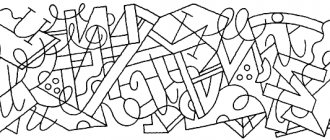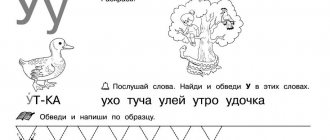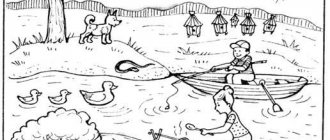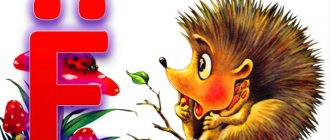Literacy training “Sounds [n], [n`] and the letter N”
Guess the riddle:
On a piece of paper, on a page - Either dots or birds. Everyone is sitting on the ladder and singing songs.
That's right, these are notes. Say the word.
- How many vowels do we hear? So how many syllables are there in a word? Which syllable is stressed?
Say 1 syllable. What sound do we hear at the beginning? What is he like? Do you know the notes?
But our online lesson is dedicated to the sound [n] . We found out that the consonant is voiced and hard. But, wait a minute... Another riddle...
He wears his horns like a royal crown. Eats lichen and green moss. Loves snowy meadows. ( Deer )
What sound do you hear at the end of the word "deer"? Is it a vowel or a consonant? Hard or soft?
This means that there are two sounds [n] , [n']. We will talk about them further.
1. Repeat the syllables.
| On - but - well - us | An - he - un |
| We - on - well - but | Eun - he - un |
| But - we - well - on | Un - an - he |
| Well - on - us - but | He - un - eun |
| On - on | Well - but |
| But - on | Well - we |
| But - well | We - well |
2. Come up with words that begin with the sounds [n] , [n'].
And here is the rhinoceros. Do you know why the animal was named that way? Why does he have a horn on his nose?
Do you know that there are many phraseological units with the word “nose”...
To hack on the nose - remember To hang one's nose - To turn up one's nose - to be arrogant one by the nose - to deceive To speak under - to speak quietly from under one's nose - to steal from a prominent place From a gingerly nose - very little To stick one's nose - to appear The nose has not grown - it is still small Poke under your nose - pester Wipe your nose - prove Poke with your nose - interfere Poke your nose - do delving into Poke your nose - incriminate A mosquito will not undermine your nose - very accurate
In pairs, come up with dialogues where it would be appropriate to use one of the phraseological units.
3. Listen to G. Yudin’s story “Pinocchio’s Nose” and try to remember as many words as possible that start with the sound [n] or [n`]
Pinocchio Nose
For the New Year, the children in kindergarten had to dress up as someone. Nikita decided to make himself a long nose and paint his cheeks, as if he were Pinocchio.
Nikita sat down on the floor, cut the paper with scissors, smeared it with glue and rolled it into a tube. I looked, and it wasn’t a nose, but a whole nose.
“I’m tired of making this Pinocchio nose,” Nikita mutters, “I’d rather tie it to my head with threads and be a rhinoceros.”
I started winding the threads. I reeled and reeled - nothing worked! Nikita pouted.
- I'll stick it directly on my head. I smeared glue on my head and applied my nose. My hair was stuck together and my nose had fallen to one side.
- I'm tired of this rhinoceros. It’s better to come after the New Year and say that I was dressed as invisible, that’s why they didn’t see me. Well, now for practical material: literary words, games, crosswords, puzzles, charades starting with the letter N.
4. Game “Name the antonyms”
Left - (right), high - (low), under - (above), upper - (lower), dry - (wet).
5. Game “Choose a word”
- Put on - (dress, stockings, fur coat, raincoat, skirt).
- Draw – (picture, drawing, boat).
6. Game “Syllable Auction”
- Add other syllables to the syllable “na” so that you get new words: na... (-sos, -genus, -weight).
- To the syllable “but” add other syllables so that you get new words: but... (-chi, -zhi, -ra).
7. Game “Syllable Lotto”. Think of children's names in which the syllable “na” would be the second syllable in the word.
Answer: Nina, Lena, Lina, Gena, Tina, Rina, Zina, Dina.
The hard consonant sound [n] and the soft consonant sound [n'] are indicated in writing by one letter. It is called the letter "en". Meet the letter N in a sock!
What does the letter N ?
1. Look carefully at the letters, find similarities and differences.
2 . Find the hidden letters H. Circle them.
3. Trace and color only those balls on which the letter H . Connect them with strings with Dunno.
4. Color the large letter blue and the small letter green on the left side of the picture. Shade the letter according to the example. Find and color the letter H on the right side of the picture.
5. Connect with the letter N only those objects whose names begin with the sounds [n] , [n`]
6. Draw the second half of the letter H on the left. Circle all the H's on the right.
7. Game “Name the antonyms”
Left - (right), high - (low), under - (above), upper - (lower), dry - (wet).
8. Game “Choose a word”
- Put on - (dress, stockings, fur coat, raincoat, skirt).
- Draw – (picture, drawing, boat).
9. Game “Magic chain”
- Replace one letter with the letter “n” in the words: ice - flax, syllable - elephant, juice - dream, cheese - son, frame - wound, puddle - moon, salki - sled, village - hay.
- How to make day out of night?
Night - zero - salt - solo - village - hay - canopy - net - child - day.
10. I gram “Anagrams”
Pump (pine), roll (rope), norma (romance), spout (socks), nochka (head of cabbage), glow (channel), nickel (spruce forest), mute (coin), mink (crown).
11. Reading...
12. We are writing...
Learn to write beautifully here
13.
Dictionary
- A tax is a mandatory payment to the state.
- Parting words are words, wishes for someone setting off on a journey, or advice for the future.
- People are the population of a certain country.
- An innovator is a person who introduces and implements new ideas.
I recommend reading:
- 77 Effective Educational Techniques
- Mathematics Olympiad (2nd grade)
- What should a child know in 1st grade?
- Cheat sheet for parents. Literacy training.
Tags: Internet Russian language
Using tactile exercises
The child’s tactile sensations also need to be connected when learning the letter n. After all, these exercises activate the brain of a small person.
- Draw a symbol on the baby’s palm, ask the child to say its name – “en” with his eyes closed.
- Draw an “H” with your palms parallel to each other and your thumb placed perpendicular.
- Draw a symbol on a sheet of white paper with a finger dipped in watercolor paint or gouache.
- Make a letter from plasticine or salt dough and decorate the resulting figure.
- Draw the letter H with the crumbs' finger on the cereal, scattered in a thin layer on a horizontal surface.
NNOD move:
Introduction to the topic
– Guys, do you like fairy tales? Who is your favorite fairy-tale hero? Today a fairy-tale hero will also come to us. And you will find out who it is if you guess the riddle:
Blue hat, Yellow pants, In the city of Flowers - The main braggart.
This Shorty tried to rhyme, But he did not become a True poet.
Many adventures happened to him, But it’s worth admitting, This boy is cute.
Who is this? Guess it! The baby's name is . (Dunno)
Children sit at tables and open their workbooks.
Game "Give me a word"
- Dunno, he wants to play the game “Give me a word” with you. Listen carefully, find the clue in your notebooks and circle the clue picture.
And the rooster with the prickly hedgehog cuts the lard with sharp edges. (With a knife)
Who alone has a horn? Guess it! (Rhinoceros)
– What is the first sound in the words “KNIFE” and “RHINO”? (“N”).
Working with mirrors. Characteristics of the sound “N”
– Say the sound “N”. In what position are the lips, teeth, tongue? What prevents sound from coming out? Tell Dunno, what sound is this? The sound “N” is a consonant, voiced hard or soft. What color do we use to indicate the consonant hard sound “N”? (blue). What about the soft consonant sound “Нь”? (green)
Game “Locate the place of the sound in the word”
– Name the pictures, emphasizing the “N” sound. Dunno does not know where the sound “N” is located in the word “ELEPHANT”. Let's give him a hint and draw a blue square in the appropriate place in the diagram.
Assignment: Printed letter N for preschoolers
Examine the letter N. Sew the letter H in the air and once in the notebook, carefully in the cells with a simple pencil or ballpoint pen.
In cases where the child is asked to write a whole line of a letter, syllable or word, the adult gives a writing sample at the beginning of the line. If a preschooler has difficulties, then an adult can draw two approximate lines, or put reference points that the child will connect with lines, or write the entire letters, and the child will simply circle them in a different color. Calligraphy should not be required at this stage of training.
Funny poems about the letter N for children
Thimble Our brothers sewed a dress, One of the brothers was king. He put on the crown. But he did not lag behind in his work. (G. Vieru)
Twin words The mink crawled out of the hole and went to the familiar hole. The mink entered the hole, but did not find the mink in the hole. If there is no mink in the hole, Maybe a mink next to the hole? Nowhere, no trace. Mink is here, BUT MINK is not! (A. Shibaev)
Different noses They stick their noses into things that are not their own, They peck their noses before going to bed, But Papa Carlo brought us one funny nose. (Ya. Akim)
Rhinoceros Whoever gives way to a rhinoceros will undoubtedly act wisely. He, the thick-skinned one, likes to jostle, but what does it feel like for the poor passerby? How good it is that such ignoramuses will be encountered less and less often! (B. Zakhoder)
Igor sticks his nose into the jam, then into the honey. Oh, I'm afraid that my nose might not stick to the jar of honey. (F. Bobylev)
Take us to Vera. - Where is she? - In the park. (Ya. Kozlovsky)
We don't need such jokes! Who cut forget-me-nots at night? There are footprints on the garden bed. This must be a rhinoceros. (G. Sapgir)
Preview:
Topic: Sounds n, n and the letter N.
Goal: to consolidate the concept of “consonant sound”;
highlighting a given consonant sound
at the beginning of a word, at the end of a word, from the text;
reproduction and reading of sound series of two sounds;
analysis of a sound series of two sounds.
Equipment: a house for consonants and vowels, the letter H large and small, dolls: three little pigs, a baby elephant, a tiger cub, a calf, a lion cub, a foal, a baby camel; blue, green and red circles; stripes with letters (H) for each child and for the teacher; cards with the words: Naf, Nuf, Nif.
1. The one who tells me the names of the piglets from the fairy tale “The Three Little Pigs” will sit down. (Naf-naf, Nuf-nuf and Nif-nif). Draw an angry wolf. Now show how scared the piglets were. Show how they hid. Now draw brave piglets, joyful piglets.
Today we will compose our own fairy tale about Nif-nif, Naf-naf and Nuf-nuf and will study the sounds n, n.
2. Exercise "Repeat"
Do the first sounds in the words Naf, Nif sound the same?
We denote the sounds n, n with colored symbols.
Is it possible to sing the sound? (No). Why? Take the mirrors. Say the sound n. How do we pronounce it? The mouth is slightly open. The tongue rises to the upper teeth and prevents air from passing through. The air encounters an obstacle and passes through the nose. The sound n is a consonant.
In which house will the sound n live? (In blue). Sounds like we will settle in... (green house). What sound is this? (soft). N' - brother of the sound n.
3. “Introducing the letter N.”
The letter N, I can tell you, is very similar to a bed. What letter does the letter H look like? (Starting with the letter i).
N put on a belt.
And put on a belt.
The letter N is put on straight,
The letter I is oblique.
Analysis of syllables: NA, NU, NI.
4. Game "Three Little Pigs".
Today is Naf-naf, Nuf-nuf and Nif-nif's birthday. What sound did you hear in the words day, Nif? (Sound n). What sound is this - hard or soft? (Soft). What color will we designate it on our stripes? (Green). Mark with a circle on your strip where the sound n is located in the word day? (At the end of the word). And in the word Nif? (at the beginning of the word).
What did the piglets send to their friends? (invitations). Who came to them?
Toys are exhibited: baby elephant, tiger cub, calf, lion cub, foal, camel.
What sound is in the names of these animals? (Sound n).
Who didn't they invite? (Teen Wolf). He decided to “annoy” them. How do you understand this word? (Children's reasoning).
The wolf cub headed towards the Piglets, and the Puppy met him. He has lost his way and does not know where to go next - right, left or straight ahead. (Children show directions). The Wolf Cub directed the Puppy to the right, along a long path, and he himself ran straight. Repeat words with the sound n (Long path, right, straight).
The little wolf ran up to Nuf-nuf's house. What rods is it made of? (Made of wood). So, the house... (wooden).
Nif-nif has a house made of straw, which means a house... (straw).
Naf-Naf has a house made of brick, which means the house... (brick).
What did Little Wolf want to do? How did the friends of Naf-naf, Nuf-nuf and Nif-nif teach the Wolf Cub a lesson? (Children's answers).
5. Physical school.
After f/m, the teacher asks what words with the sound n were in this poem?
6. Game "Be careful".
Naf-naf suggests playing hide and seek. Close your eyes and tell me who Naf-naf couldn’t find.
One or two toys are removed at a time and the children guess who is missing.
7. Signs with the words Nuf, Naf, Nif are displayed. Signs are placed on each piglet and the first syllables are read.
Progress of the lesson
1. Organizational moment. Development of phonemic representations.
The teacher greets the children.
Teacher: The one who names the eye sounds
. Then consonants.
The children answer.
Teacher: Correct! Sit down. What sound do words end with?
: elephant, dream, clown.
Children's options.
Teacher: Correct. Today in class
we will get acquainted with a new
sound and the letter
N.
2. Sound [n]
.
Articulation of sound
.
Development of visual gnosis, constructive praxis
, fine motor skills, phonemic hearing. Cultivating a soft voice attack.
The teacher places a picture of a crying girl on the board.
Teacher. Look at the picture. The girl whines n-n-n. Repeat, Misha, how the girl whines.
Child. N-n-n!
Teacher. Let's pronounce the sound
“N”
, lips in a neutral position, the tip of the tongue raised and resting on the upper incisors.
When pronouncing the sound
N, vibration of the nasal cavity is felt.
What sound
?
Children. Consonant
Teacher How did you guess that this is a consonant sound
?
Children: Because you can draw it, but you can’t sing it.
Teacher: What color circle will we use to denote it?
Children: Blue circle
3. Game “Catch the Sound”
»
Development of phonemic hearing. Isolating the sound
[H] from a number of vowel
sounds
and syllables
Teacher: You need to catch the sound [n]
. When you hear it, clap your hands. N, t, p, m, n, o, a, n. Na, ma, an, un, pa, am, but.
4. Game “Determine the place of the sound in the word”
»
Teacher. Listen to the poem and name words that begin with the sound [n]
.
Natasha has a freckled nose.
Our Nata is a first-grader.
Children. nose, Natasha, ours, Nata.
P a g o g Well done! You have heard all the words that begin with the vowel sound [n]
.
The teacher displays diagrams indicating the place of sound in a word
.
Teacher Next task. You need to determine where the sound
[n] in each of these words.
Looking at pictures that have the sound [n]
, and determining the place
of sound in a word
: thread, lemon, glass, drum, rhinoceros, night.
Teacher: Well done, you did a good job.
5. Introducing the letter N
.
Development of visual gnosis and constructive praxis
.
The teacher places a three-dimensional letter H
.
Teacher Leg, leg
A belt was placed across it.
Letter letters
“H” with a finger in the air.
How many sticks does it take to make the letter H?
?
Children: Three
Teacher Well done! You folded the letter N
, and now put the sticks in containers.
See how you can make the letter H
. Try this too.
The teacher removes the containers.
P a g o g Look at the letters H on the board
. One is big and the other is small.
6. Exercise “Find pictures”
. Development of visual perception, phonemic representations.
The teacher posts a picture.
TEACHER And now let's find on this page objects whose names also begin with this sound N
.
Children. Socks, thread, knife, scissors.
P a g o g Look at the flowers. These are narcissists. Repeat this word.
Children. Daffodils.
P a g o g What sound
does this word begin?
Children. From sound [N]
.
7. Exercise “Let’s read”
. Formation of reading skills.
P a g o g Now let's read the syllables and words.
Children, first in chorus, and then one by one, read the syllables, and then the words.
8. Physical education break.
9. Work in a notebook. Development of fine motor skills, graphomotor skills. The teacher invites children to tables, hands them open notebooks and containers with pencils.
Peda g o g What letter
do you see on the leaves?
Children. This is the letter N
.
P food g o g What pencil will you color it with?
Children. Blue.
Teacher Why?
Children. This is a consonant
.
P a g o g Color the large letter with a blue pencil
, and
first circle the small letter
and then color it.
The children complete the task, the teacher watches how they sit, how their notebooks are laid out, how they hold their pencils.
P a g o g What pictures do you see on this page?
Children. We see threads.
11 e d a g o g From what sound
do their names begin?
Children. From the sound [n]
.
11. Organization of the end of the lesson
. Assessment of children's work.
The teacher invites the children to remember what they did in class
.
Pe d a g o g With which letter
did you meet today?
Children. With the letter N
.
Pe d a g o g What letter
?
Children of Solasnaya.
P a g o g How many sticks do you need to take to form the letter N
?
D s t i. Three sticks.
Pedagogy What words starting with the sound [n] do you remember
?
Pedagogy What we did in class
?
Publications on the topic:
Summary of a subgroup speech therapy lesson on literacy in accordance with the Federal State Educational Standard “Sound [U] and the letter U” Summary of a subgroup speech therapy lesson. Type of lesson: training. Group of children according to the structure of speech impairment: FFNR Age:.
Summary of a literacy lesson for children of the preparatory group “Sound [O] and letter O” Objectives: Repetition of learned vowels, differentiating them from each other. Updating children's knowledge about the letter O. Consolidating the visual image.
Summary of a literacy lesson for children of the preparatory group “Sound [U] and the letter U” Purpose: Generalization of knowledge about the sound and letter U. Develop the ability to distinguish the vowel sound U from a number of other sounds, from words. ; selection of words for a given one.
Summary of the literacy lesson “Sound [ts]. Letter C” Objectives of the lesson: to introduce children to the letter C, teach them to read words with this letter; to form the skills of spelling correctly, express.
Summary of the literacy lesson “Sound [h]. Letter Ch. Combinations cha, chu” Objectives of the lesson: to introduce children to the letter Ch, combinations CHA, CHU, to teach how to read words and combinations correctly; develop spelling skills.
Purpose of the lesson: we study the letter N, the formation of reading skills, the development of speech skills, the improvement of phonemic awareness, the basics of elementary graphic skills.
- introduce the preschooler to the letter N and the correct pronunciation of the sound;
- teach how to write the printed letter N in squares;
- to generate interest in learning poems and riddles.
They bought little Natasha a toy horse. Natasha sat on the horse and shouted: “But-but-but!”
- How did Natasha scream?
- NNNO - what is the first sound here?
- Who bought the horse?
- NATASHA - what is the first sound in this word?
Name what is shown in the pictures below:
Scissors Sky Notes Rhinoceros
What is the first sound in the word RHINO? - SCISSORS? Is the [n] sound in the word LEMON at the beginning, at the end or in the middle of a word? WINDOW? RAM? NOTES?
When we pronounce the sound [n], the tip of the tongue hits the “tubercles” behind the upper teeth. Say: NNN. The tip of the tongue hits the “tubercles” behind the upper teeth and prevents air from freely leaving the mouth when we pronounce the sound [n].
- Vowel or consonant sound [n]?
- What other consonant sounds do you know?
- Voiced or unvoiced sound [n]?
- What other voiced consonant sound do you know? ([m])





